One of the most common questions we receive in our mailbox is "what is the best umbrella plant care and growth strategies?" This makes us wonder how many people want to grow this amazing plant!
Umbrella plants make ideal houseplants because they are hardy, quite robust, and have excellent air purifying qualities. They thrive even when their owners neglect them, but only for a little while.
If you are someone who travels a lot, the umbrella plant will be a suitable houseplant for your home, as it needs only a little amount of water and can thrive for a few weeks without care.
Table of Contents
What is an Umbrella Plant (Schefflera Arboricola)?
Umbrella plant, also known as Schefflera Arboricola, is a known fast-growing tree that originates from Taiwan.
Habitats are not known to limit its growth and development, as it grows and blossoms in a wide range of habitats. Umbrella plants can grow indoors and/or outdoors.
When grown outdoors, the umbrella plant can grow as high as 10 meters, while when grown indoors, you can regulate how tall it grows. This umbrella plant care tip would be fully discussed below.
Other common names of umbrella plants are dwarf umbrella plant, parasol plant, gold Capella, octopus plant, and Queensland umbrella tree.
Umbrella plant thrives at a temperature of 15 degrees Centigrade to 21 degrees Centigrade. It needs adequate sunlight but not direct sunlight to grow. Its varieties include variegated umbrella plant, dwarf-sized umbrella plant, and plain green leafed umbrella plant.
Its pests include spider mites and scale insects. An important quality of umbrella plant over other plants is that aside from giving off oxygen into the air, it absorbs toxins. Umbrella plant purifies the air and improves the quality of air in and around your home.
However, you should keep your pets, especially dogs and cats away from the plant, as it is toxic to these pets when they ingest it.
Read Also: The Best Time to Pick Banana Peppers
How to Grow and Care for Umbrella Plant
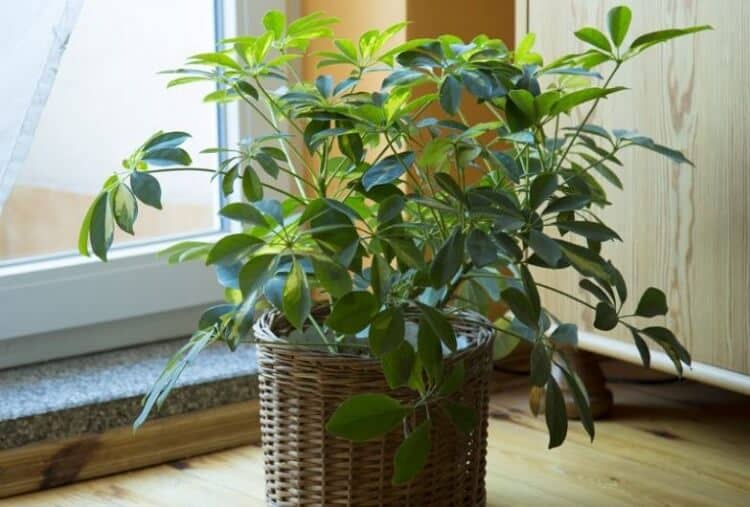
Having looked at the overview of the umbrella plant and a few of its essential qualities, let’s get to know how to grow an umbrella plant.
How to Grow Umbrella Plant
Umbrella plant is best grown in rich soil with an acidic to slightly alkaline pH. If you are growing it in a pot, use loose potting media with moist compost.
A good draining sandy loam soil is suitable as well. Ensure not to grow the plant in waterlogged soils to avoid developing root rots.
Direct sunlight burns umbrella plant leaves. So when you are planting the tree, position it in a direction where it would get bright but indirect sunlight. Umbrella plants grow well under bright sunlight.
During summer, take out the indoor plant outside but place it under a shade. An insufficient amount of sunlight causes the umbrella plant to get floppy or leggy.
Umbrella plant is a tropical plant that grows well under tropical temperatures and high humidity. Temperatures lower than 13 degrees will cause the umbrella plant to drop its leaves quickly.
When this happens, in order to save the plant, if it is being grown indoor, take the plant outside and water it. But if it is grown outdoor, water it appropriately and avoid overwatering.
Umbrella Plant Care
To fully understand how to care for an umbrella plant, we shall be discussing each umbrella plant care tip under the following sub-headings:
Watering Umbrella Plant
Whether you are growing your umbrella plant indoor in a pot or outdoor in the ground, it is necessary that you adequately water your plant.
Umbrella plant does well in damp soil, although it can withstand lack of water for a few weeks, provided you salvage the situation by watering it.
While adequate moisture is necessary for the umbrella plant’s growth, overwatering poses some real problems to the plant.
Overwatering causes umbrella plants’ leaves and stems to turn brown or become soft to feel on the inside. Root rot can also occur when an umbrella plant is overwatered.
If an umbrella plant shows any of these symptoms of overwatering, take out affected plant parts and repot the plant in a new pot to aid recovery and healthy new growth.
In order not to overwater the umbrella plant, use a little quantity of water on the plant. Also, make use of a drip tray to collect water and water the plant when you notice that the topsoil is dry to touch.
Suitable Humidity
Umbrella plants thrive in high humidity, although it tolerates typical homes or offices’ humidity levels. When umbrella plants grow indoors with low humidity, insects make homes out of it because they (insects) love the areas with low humidity.
To get rid of insects from the umbrella plant, raise the level of humidity in areas surrounding the plant.
Remember that umbrella plants thrive in high humidity, so their health would not be affected by the increase in humidity. Instead, the high humidity will keep insects away from making a home out of the plant.
Read Also: What Crops Grow Best In Alabama?
Suitable Light for the Plant
The umbrella plant thrives in both bright and dark areas of a home, office, or surrounding. However, it grows best in sunny areas that do not receive direct sunlight.
When grown in bright areas, the umbrella plant grows tall and becomes bushy. But when grown in dark areas, it will grow tall as expected, but its leaves will spread out more.
If you wish to expose the plant to direct sunlight, take the plant outside for about a few hours a day. It is important to note that excess sunlight and exposure to direct sunlight will damage the leaves.
Suitable Temperature for the Plant
The umbrella plant blossoms under average room temperature of about 15°C to 21°C, and do not tolerate temperatures lower than 13°C nor temperatures higher than 24°C. However, the various varieties of umbrella plants thrive under slightly different temperatures.
The variegated umbrella plant blossoms under temperature somewhat warmer than 21-degree centigrade, while the plain green leafed umbrella plant blossoms under temperature slightly colder than 15-degree centigrade.
The umbrella plant does not also do well when the temperature lowers suddenly. Sudden drops in temperature cause the umbrella plant to shed its leaves prematurely. To avoid this, keep your umbrella plant away from draughty doors and windows.
Fertilizer Application
The umbrella plant requires only a small amount of fertilizer to grow and maintain vitality. An all-purpose fertilizer diluted for the sake of the umbrella plant can be applied to the plant once every month, and it will keep the plant thriving.
Do not apply fertilizer to the plant during winter, when the plant stays inactive and when the plant has grown to its full ideal size.
Read Also: Perlite vs Vermiculite
Pruning procedures
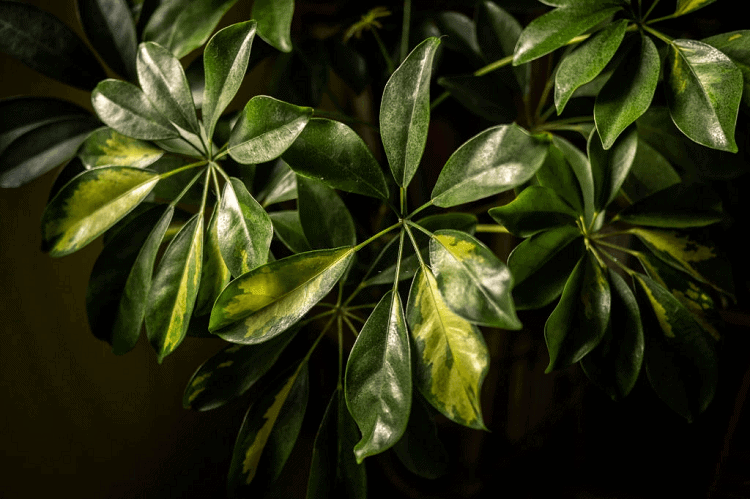
The umbrella plant is a fast-growing plant that easily grows out of control when left unattended. The pruning style to be adopted depends very well on personal choice and preference.
If you desire a shorter and bushier plant, you will have to prune the plant from the top. Cut off the upward growing tips, and this will promote growth on the lower part of the part, giving the plant a round shape appearance.
If you desire a slender looking plant, you will have to allow it to grow freely without pruning it. This will promote the upward growth of the plant into looking tree-like. However, if you allow the plant to climb indoors, it can grow as high as 6 feet.
As a result of its fast growth, excessively pruning the umbrella plant does not affect it as it quickly recovers from the trim with new growth. Pruning does not encourage its spread; its maximum width is about 18 inches.
How to Propagate umbrella plant
Propagation is used to reproduce new umbrella plants. However, the umbrella plants are known to be very difficult to propagate, but when carried out with close attention, constant practice and determination, its propagation can be achieved.
Umbrella plant is best propagated during the spring. To propagate the umbrella tree, cut out a stem of about 2 – 6 inches long. Trim off all leaves except for a set of leaves on the stem.
Plant the stem in a soil that is similar to the parent’s plant soil, alongside a rooting hormone. Ensure that the growing tip of the stem is positioned upwards.
To ensure that the propagation becomes successful, expose the new young plant to temperature as high as 24°C with a heat source to the bottom. Watering, at this point, should be minimal to avoid root rot.
Increase the quantity of water only when there are lots of new growths. At this point, the young plant can be regarded and treated as a regular umbrella plant.
The flowering of Umbrella Plant
The umbrella plant, when grown outdoors in a warm climate, produces colorful red looking flowers. These flowers are found on long stems higher than the leafy part of the umbrella plant.
When grown indoors as a houseplant, the umbrella plant does not produce flowers. Instead, it produces some unique foliage.
The variegated varieties of the umbrella plant are known to produce this foliage. They are seen to appear in various patterns of white and green on the leaves.
Repotting Umbrella Plant
As part of the care and maintenance of the umbrella plant, the umbrella plant, once it has grown to maturity, should be repotted every two years. Repotting helps the plant maintain health and vitality.
When repotting an umbrella plant, a new compost or standard potting soil should be used, a heavier and sturdier pot should be used as well. A heavier and sturdier pot keeps tall plants from tripping over.
When to repot, an umbrella plant should be during springtime. This time the plant is inactive and would not require you feeding it for about the next four weeks. The nutrients in the new compost will sustain its growth and developmental needs.
Read Also: Best Watermelon Companion Plants
Is an Umbrella Plant Toxic?
Yes, the umbrella plant is toxic as it contains a poisonous substance called ‘Calcium Oxalate Crystals,’ which are present in the leaves and stems sap.
Calcium oxalate crystals appear as tiny and sharp crystals which when comes in contact with the skin or soft tissue, stabs the skin and soft tissues of the body.
When umbrella plant leaves are eaten, the calcium oxalate in them makes one feel as though he/she is biting into a crushed glass.
If ever ingested, the crystals cause pain around the mouth, tongue, and throat. It also causes swelling, hoarseness, and difficulty in breathing.
However, large quantities of calcium oxalate crystals are hardly ever swallowed because of its unpleasantness to the mouth the first the leaf is chewed on.
This discourages children and pets, who are the usual victims to not come back for more. When the poisonous crystals are ingested, their effect is usually fatal to dogs and cats.
Prevention is said to be better than cure, if you have kids and pets, to avoid the incidence of calcium oxalate crystals ingestion, keep your umbrella plant away from the reach of the kids and pets. Also, while handling the umbrella plant, wear gloves to prevent skin irritation.
Common Diseases and Pests of Umbrella Plant
Having gone through how to grow umbrella plant and care for it, let's look at the various pests and diseases of umbrella plant:
1. Browning of Leaves
When umbrella plant leaves turn brown or become droopy, it is a sign of plant overwatering. You would know if your plant is being overwatered if the soil feels soggy or wet instead of feeling just damp.
If this is the case, you should quickly check for root rot and adjust the amount of water you put into the plant pot.
If the plant has already developed root rot, you will have to remove all affected areas as soon as possible and repot the plant to promote new growth and healing.
The umbrella plant is a hardy plant, so with proper care, it should heal fast from overwatering and any resultant disease.
Read Also: How To Protect Tomato Plants From Bugs
2. Yellowing of Leaves
Naturally, umbrella plants lose leaves to create space for new growth. This kind of natural loss of leaves occurs at the base of the plant, but when the plant loses leaves at the upper part of the plant or its leaves turn yellow, this signals problem!
Such a problem, that is, yellowing of leaves and premature falling of umbrella plant leaves, is usually caused by a sudden drop in temperature or rough handling during either moving it outdoors or bringing it indoors.
But if none of these seems to be the cause of the problem, it may also be as a result of too much heat, underwatering or overwatering.
3. Pale Leaves and Stunted Growth
Umbrella plants are usually inactive during winter and, as a result, do not produce new leaves at that time.
But if during active periods, the plant shows signs of struggled or stunted growth or has its leaves looking pale, this means that the plant lacks adequate nutrients.
To correct this, start feeding the plant with fertilizer once every month. In about eight weeks or less, the plant should have become healthy.
4. Pests of Umbrella Plant
Insect pests like spider mites and scale insects usually attack umbrella plants. Spider mites typically make a home under the leaves.
They live there and feed off the leaves, thereby creating holes on the leaves and leaving the leaves discolored.
If your leaves become discolored and poked, you might want to check for spider mites. Look at the underside of the leaves for their webs.
To keep them away from your plant, increase the humidity level of your home. Spider mites thrive in dry air, so make the environment uncomfortable for them.
Scale insects are very tiny and may live on the plant unnoticed. However, their sticky secretions give them away. They secret sticky secretions that are usually clear, but over time turns black.
This sticky secretion poses a threat to not only the plant but also to nearby household furniture and items. If the secretions spread to these items, they attract molds to them.
A scale insect infected tree is usually challenging to restore. The best option is often to get rid of the plant.
Read Also:
- Does Baking Soda Kill Powdery Mildew?
- Fastest Growing Ground Cover Plants
- Best Zero Turn Mower For Slopes
Conclusion
Umbrella plants can be grown inside or outside of a home. When grown inside, it helps purify the air. It does this when grown outside as well.
Growing and caring for an umbrella plant is something anyone can pull off, provided you are well informed. Always look out for mal-conditions and pests in the plant, especially the scale insects. When you find any mal-condition or pest, readily get rid of them and continue to maintain proper umbrella plant care.

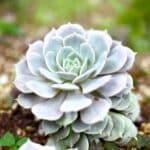

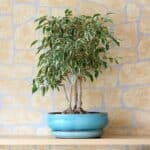
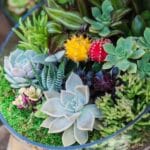
Leave a Reply